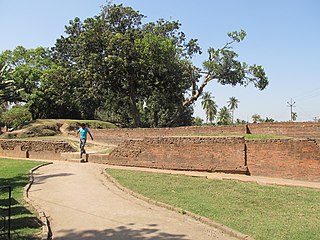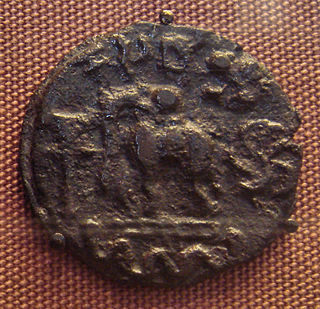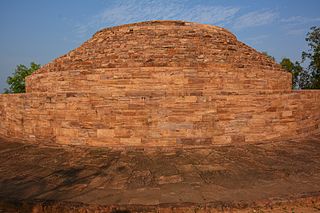
Sanchi Stupa is a Buddhist complex, famous for its Great Stupa, on a hilltop at Sanchi Town in Raisen District of the State of Madhya Pradesh, India. It is located, about 23 kilometers from Raisen town, district headquarter and 46 kilometres (29 mi) north-east of Bhopal, capital of Madhya Pradesh.

The Indo-Greek Kingdom, or Graeco-Indian Kingdom, also known historically as the Yavana Kingdom (Yavanarajya), was a Hellenistic-era Greek kingdom covering various parts of modern-day Afghanistan, Pakistan and northwestern India. This kingdom was in existence from c. 200 BC to c. 10 AD.

Mahasthangarh is the earliest urban archaeological sites discovered thus far in Bangladesh. The village Mahasthan in Shibganj upazila of Bogra District contains the remains of an ancient city which was called Pundranagara or Paundravardhanapura in the territory of Pundravardhana. A limestone slab bearing six lines in Prakrit in Brahmi script recording a land grant, discovered in 1931, dates Mahasthangarh to at least the 3rd century BCE. It was an important city under the Maurya Empire. The fortified area was in use until the 8th century CE.
Indraprastha is mentioned in ancient Indian literature as a city of the Kuru Kingdom. It was the capital of the kingdom led by the Pandavas mentioned in Mahabharata. Under the Pali form of its name, Indapatta, it is also mentioned in Buddhist texts as the capital of the Kuru mahajanapada. Modern historical research pin its location in the region of present-day New Delhi, particularly the Old Fort. The city is sometimes also known as Khandavaprastha or Khandava Forest, the name of a forest region on the banks of Yamuna river which had been cleared by Krishna and Arjuna to build the city.

Bogra, officially known as Bogura, is a city located in Bogra District, Rajshahi Division, Bangladesh. The city is a major commercial hub in Northern Bangladesh. It is the second largest city in terms of both area and population in Rajshahi Division. The Bogra bridge connects the Rajshahi Division and Rangpur Division.

Bogura District, Previously spelt as Bogra District, is a district in the northern part of Bangladesh, in the Rajshahi Division. Bogra is an industrial city where many small and mid-sized companies are sited. Bogra was a part of the Pundravardhana territory of ancient Bengal and the ruins of its capital can be found in northern Bogra.

Chandraketugarh, located in the Ganges Delta, is actually consists of a cluster of villages in the 24 Parganas district of West Bengal, about 35 kilometres (22 mi) north-east of Kolkata. The name Chandraketugarh comes from a local legend of a mediaeval king of this name. This civilization can perhaps be identified with the Gangaridai of Graeco-Roman accounts. In early historic times, Chandraketugarh was connected to the Ganga by the Bidyadhari River and must have been an important centre of trade and possibly also a political centre.

Rupnagar district is one of twenty-three districts in the state of Punjab, India. The city of Rupnagar is said to have been founded by a Raja called Rokeshar, who ruled during the 11th century and named it after his son Rup Sen. It is also the site of an ancient town of the Indus Valley civilization. The major cities in Rupnagar District are Morinda, Nangal and Anandpur Sahib. Morinda is also known as Baghwāla "[The City] of Gardens." Morinda is located on the Chandigarh-Ludhiana Highway. The Bhakra Dam in Nangal lies on the boundary with the neighboring state of Himachal Pradesh. Dadhi is one of the most important villages of the district, particularly because of Gurudwara Sri Hargobindsar Sahib.
The archaeology of Ayodhya concerns the excavations and findings in the Indian city of Ayodhya in the state of Uttar Pradesh, much of which surrounds the Babri Mosque location.

Pataliputra, adjacent to modern-day Patna, Bihar, was a city in ancient India, originally built by Magadha ruler Ajatashatru in 490 BCE, as a small fort near the Ganges river. Udayin laid the foundation of the city of Pataliputra at the confluence of two rivers, the Son and the Ganges. He shifted his capital from Rajgriha to Pataliputra due to the latter's central location in the empire.

Sculpture in the Indian subcontinent, partly because of the climate of the Indian subcontinent makes the long-term survival of organic materials difficult, essentially consists of sculpture of stone, metal or terracotta. It is clear there was a great deal of painting, and sculpture in wood and ivory, during these periods, but there are only a few survivals. The main Indian religions had all, after hesitant starts, developed the use of religious sculpture by around the start of the Common Era, and the use of stone was becoming increasingly widespread.

Kosambi (Pali) or Kaushambi (Sanskrit) was an ancient city in India, characterized by its importance as a trading center along the Ganges Plain and its status as the capital of the Vatsa Kingdom, one of the sixteen mahajanapadas. It was located on the Yamuna River about 56 kilometres (35 mi) southwest of its confluence with the Ganges at Prayaga, which made it a powerful center for trade and beneficial for the Vatsa Kingdom.

Varendra, also known as Barind, was an ancient and historical territory of Northern Bengal, now mostly in Bangladesh and a little portion in the Indian state of West Bengal.

Samataṭa was an ancient geopolitical division of Bengal in the eastern Indian subcontinent. The Greco-Roman account of Sounagoura is linked to the kingdom of Samatata. Its territory corresponded to much of present-day eastern Bangladesh and parts of the Rakhine State of Myanmar. The area covers the trans-Meghna part of the Bengal delta. It was a center of Buddhist civilisation before the resurgence of Hinduism and Muslim conquest in the region.

Lalitagiri is a major Buddhist complex in the Indian state of Odisha. The complex is home to stupas, 'esoteric' Buddha images, and monasteries (viharas), which is the oldest site in the region. Significant finds at this complex include Buddha's relics. Tantric Buddhism was practiced at this site.

Shalban Bihar is an archaeological site in Moinamoti, Comilla, Bangladesh. The ruins are in the middle of the Lalmai hills ridge, and these are of a 7th-century Paharpur-style Buddhist Bihar with 115 cells for monks. It operated through the 12th century.
Silk Road sites in India are sites that were important for trade on the ancient Silk Road. There are 12 such places in India. These are spread across seven states in India: Bihar, Jammu and Kashmir, Maharashtra, Puducherry, Punjab, Tamil Nadu and Uttar Pradesh. These sites are on tentative list of UNESCO World Heritage Sites.

Sculpture has been an indispensable part of Bangladeshi culture. Bangladesh was at times an important centre influencing stone sculpture in South Asia, especially in the post-Gupta and medieval periods. Terracotta reliefs are a particular local characteristic of Hindu temples and mosques in recent centuries.

Srughna, also spelt Shrughna in Sanskrit, or Sughna, Sughana or Sugh in the spoken form, was an ancient city or kingdom of India frequently referred to in early and medieval texts. It was visited by Chinese traveller, Xuanzang in the 7th century and was reported to be in ruins even then although the foundations still remained. Xuanzang described the kingdom as extending from the mountains to the north, to the Ganges river to the East, and with the Yamuna river flowing through it. He described the capital city on the west bank of the Yamuna as possessing a large Buddhist vihara and a grand stupa dating to the time of the Mauryan emperor, Ashoka. Srughna is identified with the Sugh Ancient Mound located in the village of Amadalpur Dayalgarh, in the Yamunanagar district of Haryana state of India. To this day, the ancient Chaneti Buddhist Stupa, probably dating to the Mauryan period, stands in the area, about 3 kilometres (1.9 mi) northwest of Sugh.

Ancient Indian architecture ranges from the Indian Bronze Age to around 800 CE. By this endpoint Buddhism in India had greatly declined, and Hinduism was predominant, and religious and secular building styles had taken on forms, with great regional variation, which they largely retain even after some forceful changes brought about by the arrival of first Islam, and then Europeans.


















